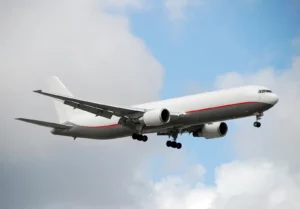
Peak season passes quietly, but air freight market remains buoyant
Peak season for air freight reached the end of its traditional period in December, with rates continuing to rise in the runup to Christmas and then tailing off as volumes dropped during the holiday period to New Year. The overall Baltic Air Freight Index (BAI00) gained a further +7.2% in the four weeks to 23 December, leaving it still a little lower by -3.1% from the level 12 months before, when there was a pronounced peak season spike. Over New Year rates then fell back a little with the BAI00 index dropping -3.7% in the week to 6 January. Nevertheless, rates were still comfortably ahead of 12 months earlier – when there was a steep fall after the peak season spike – to remain up some +25.9% YoY. For most of 2024, the index rose steadily, creating what felt like a peak season which started much earlier than usual – with rates rising slowly and steadily – and then lasting much longer than the previous year. With jet fuel prices down more than 20% over the year, according to Platt’s data, it thus turned into a much more profitable year for carriers than looked likely in early 2023 – when it seemed the industry had added rather too much capacity during the pandemic. In 2023, the market was in the doldrums much of the year, which arguably made many shippers complacent about capacity for peak season. That had to a sudden and dramatic surge during the final quarter as they scrambled to secure space. In 2024, some of the lessons of that chaotic period seem to have been taken on board – with shippers and forwarders planning ahead accordingly. It was obvious for most of the year that overall demand was rising – led by a continuing boom in e-commerce, particularly out of China. Air cargo volumes, as tracked retrospectively by IATA, were showing 10% or so YoY rates of growth all year. Capacity did increase significantly as well, augmented by some switching of freighters from less busy to more busy routes, such as away from Europe onto TransPacific lanes. The overall index was led higher most of the year by activity on the busiest lanes out of China, with the index of outbound routes from Hong Kong (BAI30) up a further +5.3% MoM through 23 December – though still -7.1% below the steep peak season high of the year before. However, even after a fall over New Year of -11.1% in the week to 6 January, it was still up +14.0% YoY – reflecting what still feels like a firmer tone to the market than a year ago. Likewise, outbound Shanghai (BAI80) continued to rise until Christmas, up another +2.0% MoM to 23 December, though below the previous year’s peak by -6.2%. And although it then fell after Christmas by -6.8% in the week to 6 January, it was also still well ahead by some +37.6% YoY. Out of Europe, rates were in the doldrums most of the year, but finally began to surge in the final quarter – caused in part by rising demand and also by a fall in capacity, partly due to the loss of access to airspace over Russia. The index of outbound routes from Frankfurt (BAI20) surged +28.3% MoM to 23 December, putting it back in positive territory by +10.7% YoY. After a further surge of +19.8% in the week to 6 January, it was up +40.8% YoY as compared with the depressed levels of a year ago. Outbound London also gained strongly by +13.4% MoM to 23 December, pushing it up by some +31.6% YoY. After a fall of -5.8% in the week to 6 January, the YoY gain slipped back a bit to +19.4%. From the Americas, the index of outbound routes from Chicago (BAI50) also rose strongly by +8.8% MoM to 23 December, though still lower at -10.0% YoY. After a further surge of +16.3% in the first week of 2025, that YoY figure had flipped to a gain of +30.9% from the level of a year before. From a macro perspective, the outlook continued to be dominated by expectations for the return as US President of Donald Trump. In the short term, this was positive for US equities, particularly the Russell 2000 index – reflecting more the outlook for domestic US companies than the S&P500, which is seen more as an index of US global trading firms. Other immediate winners were bitcoin and cryptocurrency markets – expected to benefit from a lighter-touch and more certain regulatory regime under Trump. The S&P500, however, still enjoyed another stellar year, gaining +24% during 2024 – leading some to wonder how much higher US equities can realistically go when the S&P already accounts for an incredible 75% or so of total global equity market cap. For some influential investors such as Howard Marks of Oaktree Capital, a big alternative investment firm, that valuation reflects the fundamental relative strengths of the US economy. As Marks wrote to investors recently: “[The US] benefits from a wonderful combination of free markets and the incentives they provide, dependable rule of law, stable government, highly functioning capital markets, strong higher education, reasonable levels of regulation, spirited entrepreneurship, and thus vitality and dynamism.” The US may eventually be overtaken by China as the world’s largest economy, Marks admitted, but that should not be surprising if China has almost four times the population. Compared with Europe, some would point out that the US also benefits from much more plentiful and cheaper commodities – notably energy – which are also key factors in its competitiveness and faster growth. At the same time, many of those touted as potential losers from higher tariffs under Trump – such as US companies that rely heavily on imports from China – did not see their equity prices hit, at least not yet. There are various possible explanations for this, including the fact that many US retailers, for instance, reported strong recent earnings. Plus the possibility









